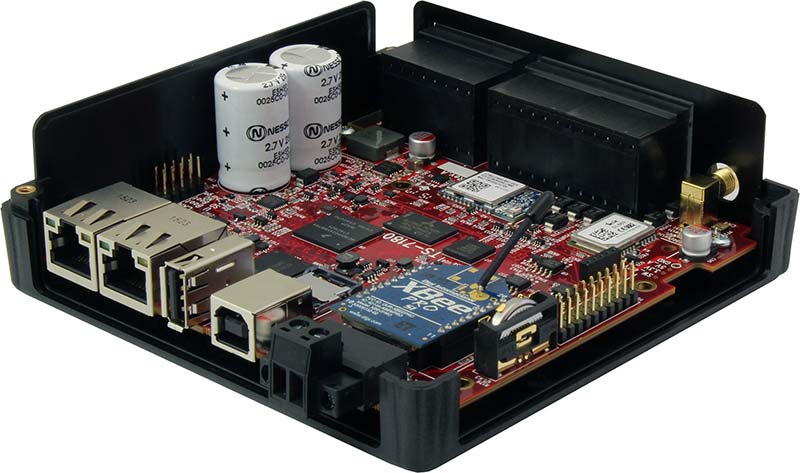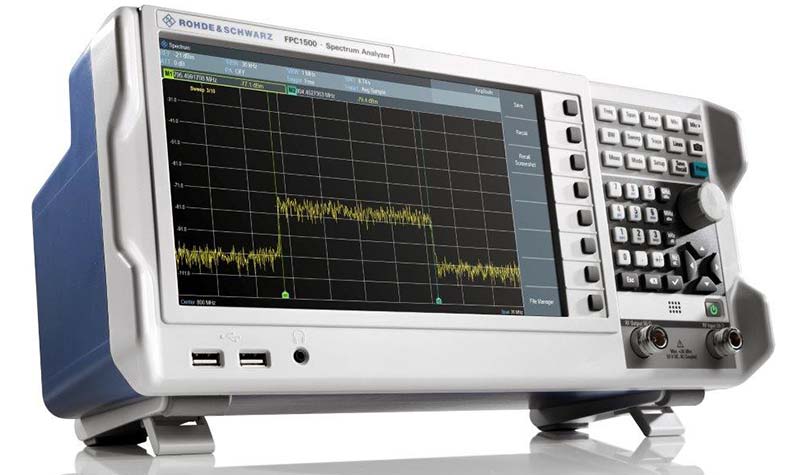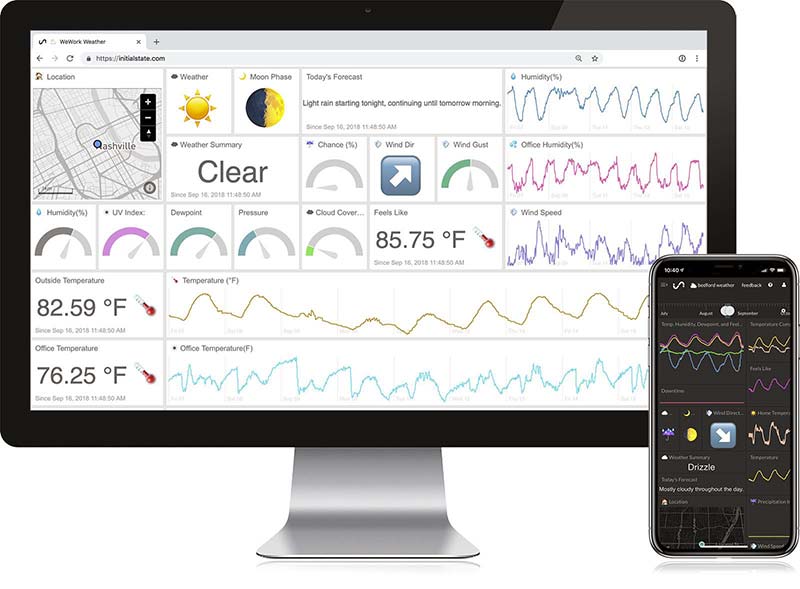■ HARDWARE ■ SOFTWARE ■ GADGETS ■ TOOLS
SBC TS-7180 in Engineering Sampling

Technologic Systems has announced that their latest single-board computer — the TS-7180 — is now part of their Engineering Sampling program which enables customers to have early access to Technologic Systems’ latest innovations, accelerates time to market, and provides a channel for customers to request technical support and design improvements directly to the engineering team. The program typically lasts for 6 to 12 months before the product enters into production.
The TS-7180 is developed for any industrial application, but is especially suited for industrial control automation and remote monitoring management applications such as unmanned control room, industrial automation, automatic asset management, and asset tracking.
The TS-7180 features the NXP i.MX 6 UltraLite processor. The i.MX 6 UltraLite is a high performance/ultra efficient processor family featuring Freescale’s advanced implementation of the single ARM Cortex®-A7 core. The NXP i.MX 6UL processors offer scalable performance and multimedia support, along with low power consumption.
The TS-7180 comes standard with 512 MB of RAM, with configurations in the family that go up to 1 GB of RAM. For onboard data storage, there is 4 GB eMMC MLC Flash that is configurable as 2 GB pSLC mode for additional system integrity. A microSD socket is available for additional storage, or removable media requirements.
For added system integrity, the TS-7180 comes standard with Cypress 16 kbit FRAM (FM25L16B). FRAM is a nonvolatile memory employing an advanced ferroelectric process that reads and writes like a RAM and retains data like EEPROMs.
It provides reliable data retention while eliminating the complexities, overhead, and system level reliability problems caused by EEPROM and other nonvolatile memories. Unlike serial EEPROMs, the FM25L16B performs write operations at bus speed. No write delays are incurred.
Data is written to the memory array immediately after each byte has been transferred to the device. Also, the TS-7180 ships with TS-SILO which will provide up to 30 seconds of reserve power in the event of a power failure.
The TS-7180 has an impressive suite of data acquisition and control options allowing users to focus on analyzing and interpreting data. There are 7x digital input/output ports that can sink up to 500 mA or withstand up to 30V at the input. The TS-7180 offers 4x channels of ADC (accessible via Linux kernel) that do not require any sort of programming to use.
Pulse width modulation (PWM) has been included for a wide variety of applications, ranging from measurement and communications to power control and conversion. The TS-7180 provides three independent 16-bit wide quadrature counters via the FPGA, and are accessed through I2C. The quadrature and edge-counter inputs provide access to a tachometer.
The TS-7180 has a host of standard industrial interfaces to ensure it will fit into any industrial application. The TS-7180 has WiFi (802.11 b/g/n) and Bluetooth (4.0BLE) onboard radios standard. Cellular connectivity is also available with either NimbeLink or MultiTech modems via the cellular sockets.
Digi’s many XBee radios are also supported. There are two 10/100 Ethernet ports, a RS-485 port, four COM ports (3x RS-232, 1 TTL UART), as well as a SPI, I2C, and CAN bus. USB Host, Device (serial console) and OTG (via daughter card header) are available. A user programmable button is also standard.
Almost all available interfaces are brought out through 40 industrial grade screw terminals, including four removable terminal blocks for UARTs, CAN, ADC, and other general-purpose I/O.
A quadrature counter, tachometer, and nine-axis MEMs motion tracking device containing a gyroscope, accelerometer, and compass, as well as a GPS receiver are optional onboard features. A temperature sensor and real time clock (battery backed) are also onboard.
Power over Ethernet is supported via a daughter card and the TS-7180 has an operating voltage supply of 8 VDC to 30 VDC. The TS-7180 operates in a broad temperature range of -40°C to 85° C.
For more information, contact
Technologic Systems
www.embeddedARM.com
New Generation of Value Instruments

Rohde & Schwarz now offers a portfolio of value class instruments, spotlighting five key technologies. The value instruments portfolio features more than 100 products and 300 accessories.
Rohde & Schwarz’s value class oscilloscopes include a logic analyzer, protocol analyzer, waveform and pattern generator, and voltmeter in the same instrument. Featuring the power of 10, Rohde & Schwarz’s value instrument oscilloscopes include a class exclusive 10-bit analog-to-digital converter (ADC), 10s of Msamples of memory, and a 10.1 inch touchscreen offering 1280x800 pixel resolution. The technology’s 10-bit ADC provides sharp waveforms and more signal details, compared to conventional eight-bit ADCs.
The R&S®RTB2000 oscilloscope’s 10.1 inch capacitive touchscreen allows users to quickly navigate pop-up menus and adjust scaling by zooming in or moving a waveform. A memory depth of 10 Msamples is available on every channel if all channels are active, or users can benefit from 20 Msamples when channels are interleaved.
The R&S®RTB2000 offers 10 times more memory than comparable oscilloscopes, allowing users to capture longer signal sequences for more analysis results. Starting at $1,370, the R&S®RTB2000 oscilloscope features a frequency range of 70 MHz to 300 MHz.
Utilizing state-of-the-art ADCs and low-noise front ends, the oscilloscope is able to precisely measure even the smallest vertical resolution.
The R&S®RTM3000 oscilloscope offers a frequency range of 100 MHz to 1 GHz and is available starting at $3,560. The oscilloscope’s 10-bit ADC provides users with sharper waveforms and more signal details.
Designed with class-leading signal integrity and responsive ultra-deep memory, the R&S®RTA4000 oscilloscope brings the power of 10 to a new level. The R&S®RTA4000 is specifically designed to address signal integrity, helping users avoid compromising measurement accuracy for an affordable instrument.
The R&S®RTA4000 also includes standard ultra-deep memory, 100 Msamples per channel, or 200 Msamples in interleaved mode, and a fast update rate to overcome any challenge. The product’s class-leading low noise allows users to maximize use of the resolution available, ultimately revealing signals that may be hidden in the noise of other oscilloscopes.
This high-resolution decimation allows the R&S®RTA4000 to provide up to 16-bit vertical resolution. Starting at $5,950, this unit also features a frequency range of 200 MHz to 1 GHz, outstanding sensitivity down to 500 µV/div, and time-based accuracy of ±0.5 ppm to ensure accurate measurements over long time periods.
Starting under $3,000, the R&S®FPC1500 spectrum analyzer has the value and capabilities of a three-in-one instrument: a spectrum analyzer; vector network analyzer, and a signal generator.
Featuring a frequency range of 5 kHz to 1 GHz, the R&S®FPC1500 can be upgraded to either a 2 GHz or 3 GHz frequency. In addition to being able to measure RF signals, it is also an RF signal generator and features a tracking generator and independent continuous wave (CW) signal generator.
The R&S®FPC1500 spectrum analyzer includes a one-port vector network analyzer with Smith chart display, a signal generator, internal voltage standing wave ratio (VSWR) bridge, independent signal source, and resolution bandwidth settings down to 1 Hz.
The R&S®FPC1500 includes a 10.1 inch Wide XGA (WXGA) display (1366x768 pixel), is Wi-Fi-enabled, and includes a remote control capability. It is compatible with iOS, Android, and PCs, and features a low noise floor and high maximum input power.
Featuring four channels, the R&S®HMP4040 power supply offers a maximum voltage of 128V and maximum current of 40A, up to 10A output current per channel; 160W of channel power is available with the R&S®HMP4040. This unit offers the same voltage range on all channels.
The R&S®HMP4040 comes standard with a dual USB/LAN interface and locates all basic functions on the front panel to allow for direct access.
Offering high efficiency and low residual ripple, the product includes a wide variety of protection features to prevent damage to the instrument and the device under test (DUT), such as overtemperature, overload, and short-circuit protection.
For more information, contact
Rohde & Schwarz
www.AskAnEngineer.us
Real Time Streaming from Devices

Tektronix, Inc., has announced the launch of a new Initial State data streaming and visualization service for individuals. The cloud-based data service — which includes unlimited data streaming and dynamic visualizations — is ideal for students, individual engineers, technologists, and electronics hobbyists. Following a free 14 day trial, the service is priced at $9.99 per month or $99 per year, and is free for students. The Initial State data service is well-suited for applications that involve real time streaming data from IoT devices, creating dashboards to visualize the data, and sending out triggers and alerts. It can also be used to capture and collaborate on test and measurement data, with features like an interactive multi-row waveform viewer accessible through a web browser.
Users can share and annotate waveforms, providing a better way to collaborate as compared to sending around screen captures.
The cloud-based Initial State platform provides a highly secure centralized repository for time-series data and untethers analysis from installed software. All visualization and analysis applications are available through a web browser.
Initial State uses AWS infrastructure and enterprise-grade best practices for encryption, data, and access management, and offers high uptime and full data redundancy. The platform incorporates a robust set of tools for a wide range of applications such as home/office monitoring, IoT device performance dashboards, GPS trackers, manufacturing line data collection, education, and energy use tracking to name a few. Among the platform’s more advanced capabilities are real time data transformations that make it easy to derive meaning from both historical and real time data without manual calculations.
Real time triggers allow users to set alarms with SMS and email notifications. Using these tools, engineers can build hosted data applications using both historical and incoming real time data.
To improve collaboration, users can add notes, comments, and emojis for specified time ranges and then cycle through annotations for presentations and review.
For more information, contact
Tektronix
www.initialstate.com



